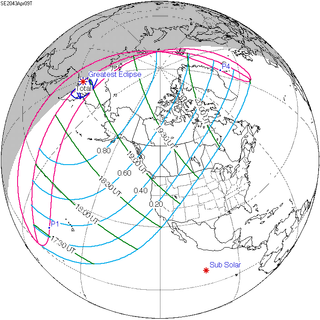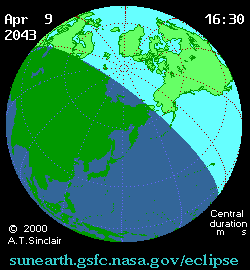Solar eclipse of April 9, 2043: Difference between revisions
No edit summary |
BobKawanaka (talk | contribs) m added link to wikipage on gamma for eclipses |
||
| Line 2: | Line 2: | ||
A total [[solar eclipse]] will occur on April 9, 2043. A [[solar eclipse]] occurs when the [[Moon]] passes between [[Earth]] and the [[Sun]], thereby totally or partly obscuring the image of the Sun for a viewer on Earth. A total solar eclipse occurs when the Moon's [[apparent diameter]] is larger than the Sun's, blocking all direct sunlight, turning day into darkness. Totality occurs in a narrow path across Earth's surface, with the partial solar eclipse visible over a surrounding region thousands of kilometres wide. |
A total [[solar eclipse]] will occur on April 9, 2043. A [[solar eclipse]] occurs when the [[Moon]] passes between [[Earth]] and the [[Sun]], thereby totally or partly obscuring the image of the Sun for a viewer on Earth. A total solar eclipse occurs when the Moon's [[apparent diameter]] is larger than the Sun's, blocking all direct sunlight, turning day into darkness. Totality occurs in a narrow path across Earth's surface, with the partial solar eclipse visible over a surrounding region thousands of kilometres wide. |
||
It will be unusual in that while it is a total solar eclipse, it is not a '''central''' solar eclipse (when the gamma is 0.9972 or larger). A non-central eclipse is one where the center-line of totality does not intersect the surface of the Earth. Instead, the center line passes just above the Earth's surface. This rare type occurs when totality is only visible at sunset or sunrise in a polar region. |
It will be unusual in that while it is a total solar eclipse, it is not a '''central''' solar eclipse (when the [[Gamma_(eclipse) | gamma]] is 0.9972 or larger). A non-central eclipse is one where the center-line of totality does not intersect the surface of the Earth. Instead, the center line passes just above the Earth's surface. This rare type occurs when totality is only visible at sunset or sunrise in a polar region. |
||
== Visibility== |
== Visibility== |
||
Revision as of 16:18, 21 February 2020
| Solar eclipse of April 9, 2043 | |
|---|---|
| Type of eclipse | |
| Nature | Total |
| Gamma | 1.0031 |
| Magnitude | 1.0095 |
| Maximum eclipse | |
| Duration | - |
| Coordinates | 61°18′N 152°00′E / 61.3°N 152°E |
| Max. width of band | - km |
| Times (UTC) | |
| Greatest eclipse | 18:57:49 |
| References | |
| Saros | 149 (22 of 71) |
| Catalog # (SE5000) | 9603 |
A total solar eclipse will occur on April 9, 2043. A solar eclipse occurs when the Moon passes between Earth and the Sun, thereby totally or partly obscuring the image of the Sun for a viewer on Earth. A total solar eclipse occurs when the Moon's apparent diameter is larger than the Sun's, blocking all direct sunlight, turning day into darkness. Totality occurs in a narrow path across Earth's surface, with the partial solar eclipse visible over a surrounding region thousands of kilometres wide.
It will be unusual in that while it is a total solar eclipse, it is not a central solar eclipse (when the gamma is 0.9972 or larger). A non-central eclipse is one where the center-line of totality does not intersect the surface of the Earth. Instead, the center line passes just above the Earth's surface. This rare type occurs when totality is only visible at sunset or sunrise in a polar region.
Visibility
It will be seen fully from Russia's Kamchatka Peninsula and Magadan Oblast. It will be visible partially throughout on north-east of Russia, in Canada, Greenland and Iceland. It will be also partially visible from the western part United States including Alaska and Hawaii.
Images
Related eclipses
Solar eclipses of 2040–2043
This eclipse is a member of a semester series. An eclipse in a semester series of solar eclipses repeats approximately every 177 days and 4 hours (a semester) at alternating nodes of the Moon's orbit.[1]
| Solar eclipse series sets from 2040 to 2043 | ||||||
|---|---|---|---|---|---|---|
| Ascending node | Descending node | |||||
| Saros | Map | Gamma | Saros | Map | Gamma | |
| 119 | May 11, 2040 Partial |
−1.2529 | 124 | November 4, 2040 Partial |
1.0993 | |
| 129 | April 30, 2041 Total |
−0.4492 | 134 | October 25, 2041 Annular |
0.4133 | |
| 139 | April 20, 2042 Total |
0.2956 | 144 | October 14, 2042 Annular |
−0.303 | |
| 149 | April 9, 2043 Total (non-central) |
1.0031 | 154 | October 3, 2043 Annular (non-central) |
1.0102 | |
Metonic series
The metonic series repeats eclipses every 19 years (6939.69 days), lasting about 5 cycles. Eclipses occur in nearly the same calendar date. In addition, the octon subseries repeats 1/5 of that or every 3.8 years (1387.94 days). All eclipses in this table occur at the Moon's ascending node.
| 21 eclipse events between June 21, 1982 and June 21, 2058 | ||||
|---|---|---|---|---|
| June 21 | April 8–9 | January 26 | November 13–14 | September 1–2 |
| 117 | 119 | 121 | 123 | 125 |
 June 21, 1982 |
 April 9, 1986 |
 January 26, 1990 |
 November 13, 1993 |
 September 2, 1997 |
| 127 | 129 | 131 | 133 | 135 |
 June 21, 2001 |
 April 8, 2005 |
 January 26, 2009 |
 November 13, 2012 |
 September 1, 2016 |
| 137 | 139 | 141 | 143 | 145 |
 June 21, 2020 |
 April 8, 2024 |
 January 26, 2028 |
 November 14, 2031 |
 September 2, 2035 |
| 147 | 149 | 151 | 153 | 155 |
 June 21, 2039 |
 April 9, 2043 |
 January 26, 2047 |
 November 14, 2050 |
 September 2, 2054 |
| 157 | ||||
 June 21, 2058 | ||||
References
- ^ van Gent, R.H. "Solar- and Lunar-Eclipse Predictions from Antiquity to the Present". A Catalogue of Eclipse Cycles. Utrecht University. Retrieved 6 October 2018.





